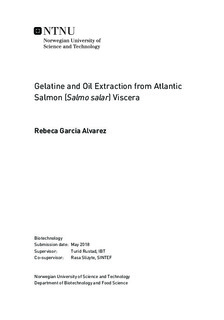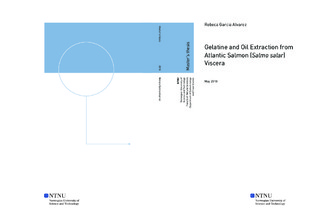| dc.description.abstract | The production of marine rest raw materials in Norway amounted to 909 742 tons in 2016. Around half of these materials are used for silage production, and only 10% was used for human consumption. Viscera represent the largest fraction of rest raw materials obtained in the farming of Atlantic Salmon (Salmo salar) and contains a high content of lipids and proteins that can be used in the production of value-added products.
The objective of this study was to evaluate the potential of salmon viscera as a raw material for the extraction of high quality oils and gelatine. Heat treatment at different temperatures was used to separate the oil, and two gelatine extraction methods (salt pre-treatment and acid pre-treatment) were used to extract the gelatine.
The oil yield after heat treatment was high (≥84.4%) and did not seem to be affected by the different temperatures used in the extraction of oil. The quality of the oils extracted was low (high peroxide values and free fatty acid content) but within the normal range for crude oils. Oil was extracted from salmon viscera with and without roe and milt, and the content of lipids was found to be higher in the viscera without roe and milt. In addition, for extraction temperatures below 48.5 °C, the viscera with roe and milt had higher peroxide values.
The gelatine extracts obtained were analysed to determine the effect of the pre-treatments in the yield and purity of the gelatine extracted from viscera without roe and milt. The viscera were divided into two parts, one was subjected to separation of oil prior to gelatine extraction and the other part was used directly (with oil) for the gelatine extraction. In regard to hydroxyproline yield, the salt pre-treatment was more effective in the extraction of viscera with oil, and the acid pre-treatment was more effective in the extraction of viscera without oil. The SDS-PAGE analysis of the freeze dried gelatine extracts showed that the salt pre-treatment has more degraded protein components than the acid pre-treatment.
The results of this study suggest that in regard to yield, salmon viscera are a viable source of lipids and gelatine, but since this raw material is prone to deterioration, measures should be taken to inhibit endogenous enzymatic activity and lipid oxidation. | |

